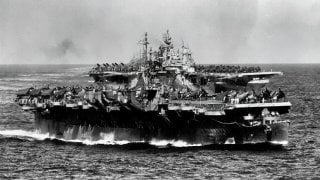U.S. Navy Independence-Class Aircraft Carriers: A Big Mistake or Amazing?
In the lead-up to WWII, President Franklin D. Roosevelt recognized the need to expand U.S. naval air power. With limited resources and the urgency of war, the U.S. Navy quickly converted nine cruisers into Independence-class aircraft carriers.
Summary and Key Points: In the lead-up to WWII, President Franklin D. Roosevelt recognized the need to expand U.S. naval air power. With limited resources and the urgency of war, the U.S. Navy quickly converted nine cruisers into Independence-class aircraft carriers.
-Despite their shortcomings, including small flight decks and limited aviation facilities, these carriers played a crucial role in the Pacific theater, participating in key operations from the Marshall Islands to Okinawa.
-While postwar analysis highlighted their limitations, the Independence-class ships exceeded expectations, demonstrating the effectiveness of carrier-based air power. Their legacy paved the way for the more advanced carriers that followed.
The Legacy of Independence-Class Carriers: Pioneers of Modern Naval Air Power
With the Second World War looming in the 1930s, U.S. President Franklin D. Roosevelt recognized the importance of expanding America’s naval air power. Several militaries began toying with the concept of launching aircraft from ships in the early 20th century. Notably, the British converted merchant ships into carriers during the First World War. The U.S. followed suit and made its first attempt to convert the large Jupiter vessel into the Navy’s first-ever aircraft carrier. Although the USS Langley was slow and had limited hangar capacity, she represented future possibilities for America’s naval air power.
With tensions ramping up across the globe, the U.S. called a naval disarmament conference in 1921. The resulting Washington Treaty sharply curtailed the sea-based construction of its signers. The major Allies of WWI that agreed to use this treaty for preventative war measures include the British Empire, the U.S., France, Italy, and Japan. By the next decade, however, both Japan and Italy renounced the treaty, and implementing naval arms limitations became increasingly difficult for the other signatories.
The Rise Of The Aircraft Carrier In WWII
Prior to the outbreak of the Second World War, then-president Roosevelt proposed to expedite the U.S. Navy’s capabilities. At the time, a former Assistant Secretary of the Navy asserted that no new and enhanced aircraft carriers were expected to enter service until 1944 at the earliest. In fact, the vessels ordered under the Two-Ocean Navy Act of 1940 included large numbers of new carriers, however, the pace for their development was stinted by the service’s additional need for battleships. With this in mind, Roosevelt called for converting some of the Navy’s existing cruisers into these floating airports.
After the Japanese attacked Pearl Harbor in 1941, the need for additional carriers became prioritized. Although officials understood that quickly converting existing boats into carriers would deem them less capable than desired, the need for these types of vessels was pressing.
The Navy created its Independence-class ships out of this desperation, as an interim measure to ensure that its sailors and pilots were better equipped to fight the remainder of the war.
Introducing The Independence-Class Carriers
A total of nine cruisers were converted into carriers in the Independence-class. Like the Navy previously feared, the new ships possessed several key shortcomings. The aviation facilities aboard these vessels were tiny and their smaller flight decks made it very challenging for pilots to land aircraft upon.
Nonetheless, these carriers entered service alongside the first of the Navy’s Essex-class carriers in 1943. The Independence (CV/CVL-22) was the first to serve the Navy as a small aircraft carrier, followed by Princeton (CV/CVL-23), Belleau Wood (CV/CVL-24), Cowpens (CV/CVL-25), Monterey (CV/CVL-26), Langley (CV/CVL-27), Cabot (CVL-28), Bataan (CVL-29) and San Jacinto (CVL-30).
Independence-Class Ships Performed Better Than Expected In WWII
As soon as these carriers entered service with the Navy, they immediately saw action in the Pacific. From operations in the Marshall Islands to Okinawa and beyond, the Independence-class ships played a critical role in the war effort. In the aftermath of the war, these carriers were expended as an atomic bomb target. The Navy concluded in a postwar analysis that the Independence-class carriers were too small to be truly effective, noting that while these ships “inflicted more damage on the enemy than they would have inflicted, probably, had they been built as cruisers,” they also suffered from shortcomings that would deem them as not ideal for future conflicts.
What The Aftermath Of The War Meant For The Independence-Class Ships
Despite the service’s postwar slamming of the Independence-class vessels, eight of the surviving ships remained active. In fact, the USS Bataan was notably active in the Korean War. The surviving carrier was recommissioned in 1950 at Philadelphia after being relegated to the naval shipyard a few years earlier.
The USS Bataan flew Vought F4U-4 Corsair fighters over Hungnam to support evacuation efforts of the American and South Korean troops being shipped to the southern Pusan perimeter. Following this evacuation effort, the carrier launched fighters to pursue reconnaissance and close air support missions.
The USS Cabot also underwent wartime modernizations in the 1950s to retain an edge over competitors. In 1967, the carrier became the Spanish Navy’s aircraft carrier where it would serve for more than two decades.
The re-emergence of USS Independence-class ships during the Korean War was short-lived, and by the early 1970s, all but the USS Cabot were decommissioned. Since the quick conversion of the interim Independence class, the U.S. Navy has all but perfected its carrier capabilities and functions.
Today, the Navy’s Ford-class and Nimitz-class ships are considered by many to represent the best aircraft carriers across the globe.
About the Author
Maya Carlin is an analyst with the Center for Security Policy and a former Anna Sobol Levy Fellow at IDC Herzliya in Israel. She has by-lines in many publications, including The National Interest, Jerusalem Post, and Times of Israel. You can follow her on Twitter: @MayaCarlin.
Image Credit: Creative Commons.


